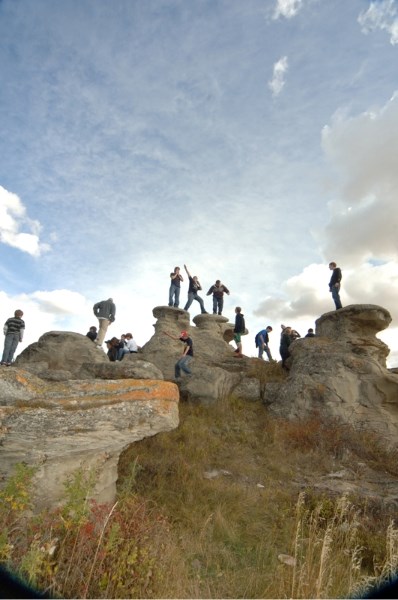There are sacred places in Mountain View County.These are ancient burial grounds, buffalo kill sites, and forgotten communities where evidence of existence is measured only by remnants of rock teepee rings.And while the region's First Nations citizens consider these sites culturally divine they are also held as valuable archaeological resources, spread across the county, from east of Carstairs to the far edge of the foothills west of Sundre.The county may lag behind other jurisdictions when it comes to managing its heritage resources from the relatively recent pioneer era, but it has emerged as a leader in the province in identifying ancient archaeological sites. Red Deer County, for example, has set the standard for rural municipalities in heritage resource management, but it has never conducted an inventory of its potentially vast array of archaeological sites.ìMountain View County should be commended for its forward thinking,î said Neil Mirau, senior archaeologist for Arrow Archaeology Ltd., a company based in Coaldale.Mirau's company was contracted three years ago to conduct a historical resources overview of the county. The vast majority of the 458 sites examined were archaeological ñ sites or objects produced by humans. The archaeologists also looked at sites that fell within the paleontological category ñ works of nature holding fossilized evidence of extinct life forms.The work was critically important, as many treasured archaeological sites have been destroyed from decades of cultivation, oil and gas exploration, forestry, mining and gravel pit development.ìMountain View County has a lot of great agricultural land. The same is true all over the province,î said Mirau. ìThere are a lot of sites that have been destroyed.îMirau's team examined many significant sites in the county used by First Nation peoples hundreds of years ago. They included rock cairns, kill sites where bison were hunted and killed, teepee communities, burial sites, and most significant of all, the Carstairs pictographs, a sacred First Nation setting where more than a dozen ancient pieces of rock art were believed to have been created by the Siksika Nation, members of the Blackfoot Confederacy.ìIt is a remarkable site. There are not many rock art sites like it in Alberta,î said Mirau, adding the drawings were created by using red ochre, an iron oxide. ìIt is one of the few well preserved red ochre sites in the province. Unfortunately some of them have been vandalized.îHe said it is difficult to determine the meaning of the pictographs. They may have been created as a historical record of the people or events at that time. The pictographs also could have been ceremonial.Whatever the reason, senior provincial government officials say the Carstairs pictographs are a significant and important archaeological site that deserves protection.ìThey are rare. They are expressions of prehistoric ideas and activities. It is a highly significant site,î said Brian Ronaghan, director of archaeological survey for the province's historic resources management branch. ìThey warrant protection and (provincial) designation as best as we can do. I think it could come in time.îAs for possible future municipal protection of the site, which is on private land, county officials say it has not yet been discussed.ìRight now that question would be answered if somebody applied for development on that site,î said John Rusling, interim director of planning and development for Mountain View County.In the Arrow report there is a recommendation that planners and developers who are proposing new activity on sites that have recorded or suspected historical resources seek the approval of the provincial government's historical resources branch.ìIt has to happen if it (proposed development) is in an area where there is a high probability of having significant historical or archaeological resources,î said Rusling, who is aware of a government website listing of all significant archaeological sites in the province and county. ìWe send them (developers) off to talk to the province. They would have the call to determine if impact assessments are necessary.îRonaghan said there is good compliance from developers across the province to work with municipalities and his department to ensure significant archaeological sites are protected. As well, most rural municipalities, including Mountain View and Red Deer counties, will alert his department of a proposed rural development to see if any archaeological sites, recorded or suspected, will be impacted.If there is any doubt, an impact assessment can be ordered under the provincial Historical Resources Act, said Ronaghan.ìWe partner with other agencies like Alberta Environment in regulating development,î said Ronaghan, who added that while thousands of impact assessments are ordered annually some are missed. ìThings can go under the radar.îAnd while challenges remain with archaeologists to uncover the remains of ancient history beneath the rich soils of Alberta, including Mountain View County, there is optimism that with good field practices and current tight government controls, a great deal of it can be recorded and protected.ìHaving worked in other jurisdictions in both Canada and the U. S., Alberta is right at the top in terms of protecting and preserving historical resources under its jurisdiction,î said Mirau.



